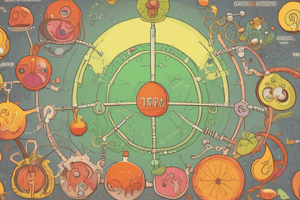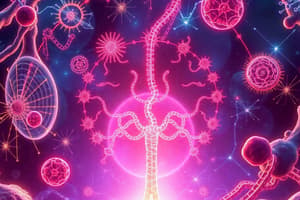Podcast
Questions and Answers
What is the primary function of the Krebs cycle?
What is the primary function of the Krebs cycle?
- To convert glucose into pyruvate
- To transport oxygen in the blood
- To produce energy through the oxidation of acetyl-CoA (correct)
- To synthesize proteins from amino acids
Which compound enters the Krebs cycle to initiate the process?
Which compound enters the Krebs cycle to initiate the process?
- Fructose
- Lactate
- Acetyl-CoA (correct)
- Glucose
Which of the following is a product of the Krebs cycle?
Which of the following is a product of the Krebs cycle?
- NADH (correct)
- Pyruvate
- Glucose
- Fatty acids
How many cycles of the Krebs cycle occur for each molecule of glucose metabolized?
How many cycles of the Krebs cycle occur for each molecule of glucose metabolized?
What is the main purpose of the electron carriers produced during the Krebs cycle?
What is the main purpose of the electron carriers produced during the Krebs cycle?
Flashcards are hidden until you start studying
Study Notes
Krebs Cycle Overview
- The primary function of the Krebs cycle is to produce energy through the oxidation of acetyl-CoA, generating high-energy electron carriers and ATP.
- The cycle contributes to cellular respiration by breaking down organic molecules, ultimately aiding in the production of adenosine triphosphate (ATP).
Initiating Compound
- Acetyl-CoA is the compound that enters the Krebs cycle, derived from carbohydrates, fats, and proteins through metabolic processes.
Products of the Krebs Cycle
- The Krebs cycle produces several significant compounds:
- Carbon dioxide (CO2) - a waste product expelled from the cell.
- NADH and FADH2 - high-energy electron carriers that are crucial for the electron transport chain.
- A small amount of ATP.
Cycle Throughput per Glucose
- For each molecule of glucose metabolized, two cycles of the Krebs cycle occur. This is because each glucose molecule is split into two pyruvate molecules, with each pyruvate resulting in one cycle.
Role of Electron Carriers
- The main purpose of the electron carriers (NADH and FADH2) produced during the Krebs cycle is to transport high-energy electrons to the electron transport chain, where their energy is harnessed to produce ATP through oxidative phosphorylation.
Studying That Suits You
Use AI to generate personalized quizzes and flashcards to suit your learning preferences.




